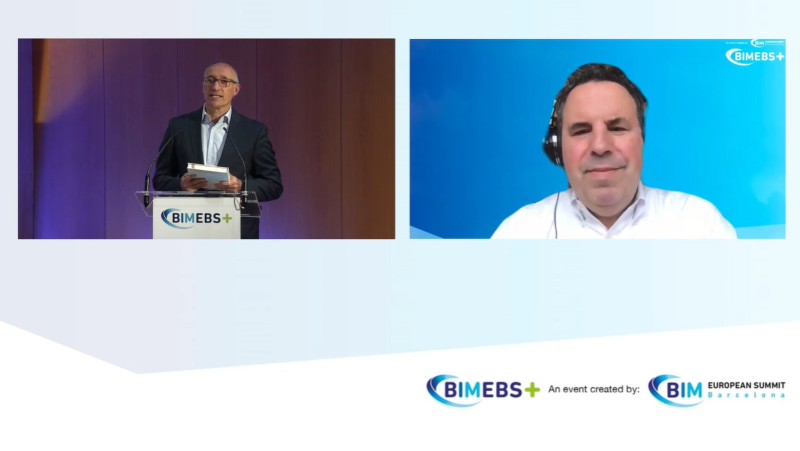The organisation of the European BIM Summit is already working on the agenda for the 2021 event, the idea being to combine the attendance-based and online formats. The experience of the online congress held on November 19 was very positive and the aim now is to make the most of its strong points in order to make forthcoming events even better. We talked about this to the content manager, Ignasi Pérez Arnal.
The European BIM Summit online featured more than 400 registered delegates from 44 countries all over the world. A total of thirty internationally-renowned speakers participated and provided a broad variety of insights and experiences that brought to light the differences in the degree of implementation of digital technologies in the AECO sector.
The first conclusion is how far behind we are in Spain. “There is a great deal of work to be done. While other countries are progressing at high speed, in our country the esBIM commission has been closed for two years now and the interministerial group no longer meets”, Ignasi Pérez Arnal bemoans. “Every passing day is yet another day in which we accept that building sector has to operate this badly”, he adds, giving examples of major projects in the metropolitan area of Barcelona, such as the square of Glòries, the number 9 underground line or La Sagrera station, which are years behind schedule.
“We really need to take the reconversion of the sector seriously”, warns Pérez Arnal. At the congress in November we were treated to experiences such as the one being developed in Singapore, as explained by Tai Fatt Cheng, the representative of the Asian country’s Building and Construction Authority. There, the administration is totally committed to the digitisation of building. “In our setting, there apparently continues to be a preference for delays and changes and we therefore have to meet overcosts instead of being able to assign part of this money to the implementation of BIM throughout the AECO sector”.
Practical applications of BIM
The European BIM Summit online showcased some practical applications of digital tools in specific projects. For example, as in the case of the software by Finalcad, a congress Gold partner. “One of the main difficulties in the BIM world is that implementation takes place in the design and planning phase but not in the actual building or on-site. It is very interesting to see that there are applications that seek to take BIM to sites, because it is, first and foremost, a tool for improving building”, states Pérez Arnal.
Another highly interesting experience is that of the Roca Warsaw Unit, a Main partner of the European BIM Summit. “Digitisation helps to spread workgroups all over the place. A unit in Poland of a leading worldwide company is working to take BIM to the actual manufacturer. If they are to have practical applications, BIM elements must be converted into a model that I can integrate into my project. If I can access the product digital catalogue I can apply them easily”.
Master Builders, a Sustainability sponsor of the BIM Summit, placed the emphasis on the responsibility of the AECO sector in taking care of the planet, “the integration of BIM in sustainability”. The building sector cannot ignore the United Nations’ Sustainable Development Goals. In each project, we should be able to gauge the extent of our impact on pollutant emissions”.
Ignasi Pérez Arnal also highlights the applications for the management of hydraulic infrastructures. “We are used to working in terms of the building and construction of buildings, but water management is one of the main problems faced by civilisation, and BIM facilitates this”.
Another core aspect addressed at the Congress was the management of projects already built, which can be done with digital twins. “It is an exact representation of the building which, through the installation sensors, allows us to see everything that is going on”.
The European BIM Summit, moving onwards
Ignasi Pérez Arnal draws attention to the international impact and how the simultaneous participation of speakers located in geographically separated places such as Singapore and Chile, for example, was one of the success stories of the online congress.
Another key milestone is that “we have gone from disseminating information to generating knowledge”, thanks to the three collaborative working documents which were presented and discussed and were left open to subsequent inputs from the sector. “We enjoyed the collaboration of professionals from different countries, with different approaches and practical experience, enriching the congress’s content even further”.
The interest of this initiative is endorsed by the fact that “we have received requests from people to access the documents after the congress even although they did not participate in it. This attests to the importance of our achievements. The most outstanding thing is not having received more or fewer inputs, but rather of making these documents available for the international BIM community to participate”, says Pérez Arnal.
He is optimistic with regard to future editions and the progressive implementation of BIM. “A hybrid format BIM Summit has the potential to attract the attention of thousands of people. BIM is not yet massive, although there is an increasingly greater interest being evinced by all the sector professionals. We were the first to propose an international congress about the topic, and the fact that interest is growing is indicative of the change that is afoot. Each and every participant is a driving force of change in their own area”, he asserts.
Innovative concepts
One of the presentations that generated the greatest degree of interest by Randy Deutsch, the architect, writer and professor from the University of Illinois. His latest book introduces the concept of super users, according to which “the building professional becomes a super user of the new technologies”.
Pérez Arnal highlights another innovative concept that attracted his attention: Integrated Design Delivery (IDD). This topic was addressed by Tai Fatt Cheng. It takes the concept of Integrated Project Delivery (IPD) to the next level. “It is not only about collaborating in project planning, but also in designing the project. If we talk about industrialised building, then it is essential that everyone involved in a project be involved in it from the word “go”. We need to know all the data and needs at the design phase”.
The European BIM Summit is possible thanks to the contribution of our sponsors: Roca, as Main partner; Finalcad, as Gold partner; Agència Catalana de l’Aigua, ATL, Infraestructures.cat, Bentley, CIAT, FGC, MUSAAT, PREMAAT, Graphisoft Archicad, SIMBIM Solutions, Ineco, ASP Corredoria d’Assegurances and Suez, as Silver partners; Calaf Constructora, Copisa and Fundación Laboral de la Construcción, as Pro partners; and Master Builders Solutions, as Sustainability sponsor. It has also the support and the collaboration of the Departament de Territori i Sostenibilitat of the Generalitat de Catalunya.






